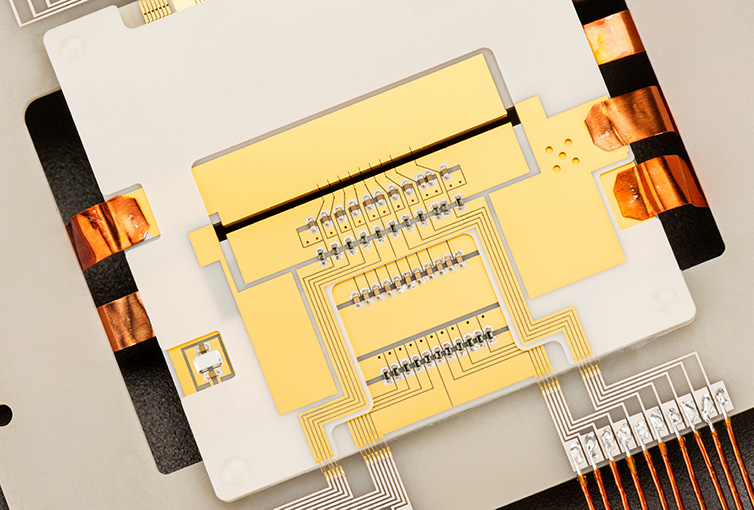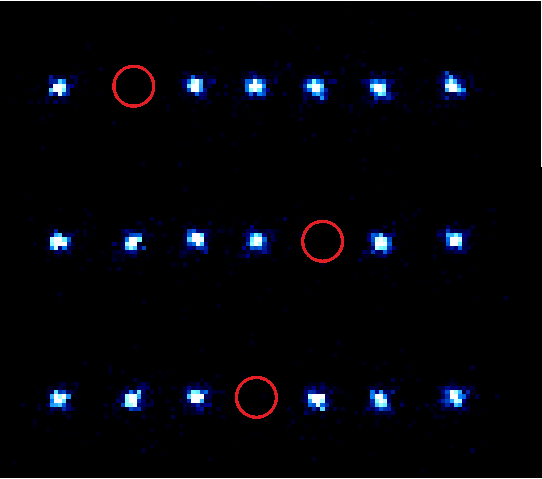Resources
 Part of the Oxford Instruments Group
Part of the Oxford Instruments Group
Expand
Collapse
 Part of the Oxford Instruments Group
Part of the Oxford Instruments Group
Optical clocks based on single trapped ions are among the most accurate devices built to date [1]. The remarkable systematic uncertainties achieved by these devices comes from the excellent control over the ions’ environment. However, as a single absorber is used, the low signal-to-noise ratio is a fundamental limit in the stability of these devices. We work on building optical clocks using simultaneous interrogation of multiple ions in an ion Coulomb crystal to reduce the necessary averaging time to reach a certain accuracy [2]. For this we use 115In+ as clock ions and 172Yb+ ions to sympathetically cool Indium. We recently showed, that the low systematic uncertainties of a single ion can be extended to a larger ion Coulomb crystal, given the right trap design [3].
We trap the Ytterbium and Indium ions in a precision rf ion trap, based on laser-cut Aluminum-Nitride wafers, see Figure 1. The ions are produced via photo-ionization of neutral atom beams from two ovens.

Figure 1: High precision AlN Trap. The central 1 mm slit holds multiple trapping areas, each able to trap several 100 ions.
Due to the excellent control of the dc and rf voltages applied to the trap, we can form and manipulate a wide range of different ion Coulomb crystals, including mixed species crystals made up of Indium and Ytterbium ions, see Figure 2. The fluorescence of the 2S1/2 to 2P1/2 transition in Yb+, with a wavelength of 370 nm and a linewidth of 20 MHz, is imaged on an Andor iXon Ultra DU897 UCS-UVB EMCCD camera with the help of a self-built objective with a magnification of 24.

Figure 2: Images of a mixed ion Coulomb crystal. The ion chain consists of 6 Yb+ ions (visible) and 1 In+ ion (marked with red circles). Collisions with background gas heat up the crystal and can lead to a different order of the ions after recrystallisation.
The spatially resolved imaging of the ions’ fluorescence allows for simultaneous state-detection over a complete crystal in a few ms. Besides clock spectroscopy, we use Coulomb crystals to investigate many-body physics, e.g. the formation and dynamics of topological defects [4] and atomic friction between two ion chains [5].
In the future, we want to detect the internal state of Indium ions. The narrow linewidth of just 360 kHz of the 1S0 to 3P0 transition at a wavelength of 230 nm makes this challenging. But with a new, more efficient detection setup optimized for 230 nm and the high EM gain factor of the iXon Ultra 897, coupled with its low readout- and spurious charges noise, spatially resolved state detection of Indium ions can be achieved. Another important feature of the iXon Ultra is the camera link output, which allows fast, direct readout of camera images without having to rely on the standard USB connection. This feature will be used to react to changes in the crystal structure during a measurement run, to trigger a reordering of the crystal if necessary.
[1] Huntemann, N., Sanner, C., Lipphardt, B., Tamm, C. & Peik, E. Single-Ion Atomic Clock with 3 × 10−18 Systematic Uncertainty. Physical Review Letters 116, 063001 (2016).
[2] Herschbach, N., Pyka, K., Keller, J. & Mehlstäubler, T. E. Linear Paul trap design for an optical clock with Coulomb crystals. Applied Physics B: Lasers and Optics 107, 891-906 (2012).
[3] Keller, J. et al. Controlling systematic frequency uncertainties at the 10-19 level in linear Coulomb crystals. Phys. Rev. A 99, 013405 (2019).
[4] Partner, H. L. et al. Dynamics of topological defects in ion Coulomb crystals. New J. Phys. 15, 103013 (2013).
[5] Kiethe, J., Nigmatullin, R., Kalincev, D., Schmirander, T. & Mehlstäubler, T. E. Probing nanofriction and Aubry-type signatures in a finite self-organized system. Nature Communications 8, 15364 (2017).
PD Dr. Tanja Mehlstäubler
QUEST (Institute for Quantum Metrology)
Physikalisch-Technische Bundesanstalt (PTB)
Bundesallee 100
38116 Braunschweig
Germany
Phone: +49 (531) 592 4710
E-mail: tanja.mehlstaeubler@ptb.de
Web: http://www.quantummetrology.de/quaccs/home/
Date: January 2020
Author: J. Kiethe, T. Mehlstäubler, QUEST (Institute for Quantum Metrology), Germany
Category: Application Note
